More On Downton Abbey - A Blog Exclusive!
This week was supposed to be a post on Intelligent Economy, however, one does have to dance with the moment, and when an exclusive opportunity is offered, as the originator of this blog I reserve the right to veer in a different direction if circumstances suggest a change of plan.
Since starting the blog a mere three weeks ago, I have received emails from several followers who have materials they believe might be of interest to me - I have been amazed by their generosity. You'll hear about them as time goes on. Bryan Webb is one of those readers, and last week he emailed to inform me that he had some photographs of the filming of war scenes for the new series of Downton Abbey that no one else had seen - he was involved in preparing the trenches for filming (correct me if I have that wrong, Bryan). I received those photographs this morning, and a few took my breath away, they were so realistic – when you look at them remember that it's a set and no real horses were harmed in the filming, however, also remember that war is terrible and imagine those scenes multiplied a thousandfold and the dreadful memories that men who came home lived with. But first, a bit about the Khaki Chums.
Long before filming begins on any production, scouts are sent out to find suitable locations. Finding a farmer who doesn't mind his land being churned up to become a battlefield is something of a challenge – despite remuneration offered, having a film crew tramping all over your property is a pain. However, the producers of Downton Abbey must have been thrilled to bits to learn that a ready-made trench was waiting for them – courtesy of a man named Taff Gillingham.
Gillingham is a member of the Khaki Chums, who are not a reenactment group, but a cadre of enthusiasts (authors, historians, collectors) who have a mission to inform the public about the experience of the citizen soldier. In a BBC interview Gillingham said, "First hand experience can teach you stuff that reading a book or watching a film never could … if you can smell it, taste it and feel it, it is a real experience." Bryan Webb is one of the Chums, who were conscripted to bring a realism to war scenes in the new series of Downton Abbey – and he and his wife enjoy my books, which brings us back to the beginning of this post, and I know you are aching to see those photos of the Downton Abbey WW1 set, so here we go:
Here are two photos of dead horses. Hundreds of thousands of horses were killed on the Western Front alone – they suffered devastating wounds from the shelling, were gassed and endured dreadful skin conditions and poor fodder.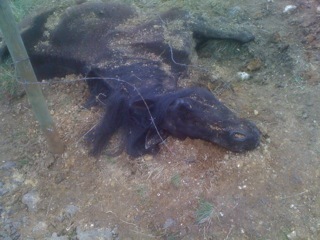
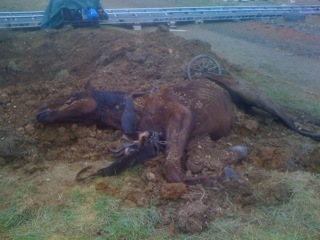
Even though it was a "dummy," that black horse with the long mane brought me to tears, reminding me of my own horse, Oliver, a young Friesian – I don't know what I would have done, had I lived then and the men from the army knocked at the door with a requisition notice. If you weep at these photos, then take a big box of Kleenex when you go to see The War Horse, Steven Spielberg's adaptation of Michael Morpugo's terrific book, due to hit the screens later this year.
When you read about the Great War, the never-ending mud seems to play a very big part: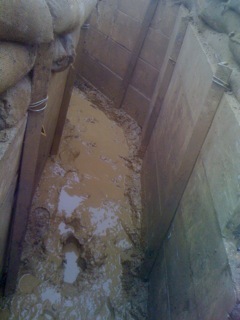
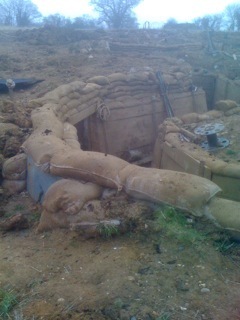
A couple more photos from the set:
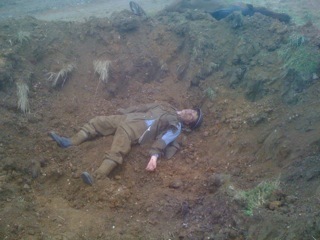
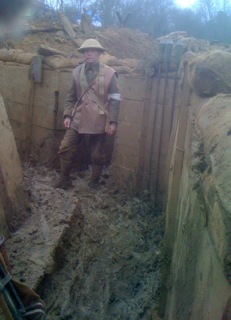
And this is Bryan:
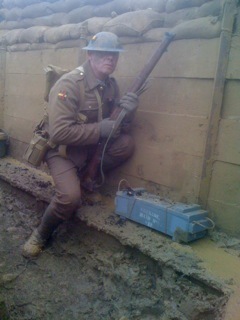
Here's what Bryan said about his experience: "Attention to detail on the set was incredible. I spent some time on the set when everyone had gone to lunch and in those quiet moments, my reflection was with those back nearly 100 years ago."
Bryan has also visited the Menin Gate memorial and the battlefields of France and Flanders many times, and comments: "Every time we are at the Menin Gate in Ypres for the Silence, I can feel that loss. Some early mornings on the battlefield, just as the sun comes up, there is an overwhelming sense of peace which contrasts the events we are there to remember."
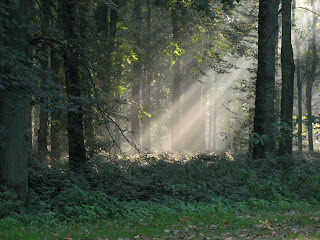
I took that photograph in Delville Wood, in France. Beneath those warming rays of sunshine the remains of many "missing" British and South African solders have been buried since 1916. This idyllic scene belies the fact that parts of the wood are out of bounds, due to unexploded ordinance that also rests beneath the ground.
The truth is that the population at home had little idea about the truth of battle, or of the everyday lives of the soldiers (much time waiting for battle while waging war with lice in their clothing). They only knew that everyone had to "do their bit." I wonder about that a lot, the fact that today our armies are engaged in war overseas and we understand so little about their true experiences, the pressures, the good times, the horrendous times. And most of us have suffered no deprivation as a result of war. It's important to remember that real soldiers don't pack up and leave the set every day, so I admire Bryan's living history commemorative group, the Khaki Chums, and their mission.
You might be interested in an essay I wrote following my first visit to the battlefields of The Somme and Ypres, in 2004: http://jacquelinewinspear.com/essays-skylarks.php
I'd love to hear your comments on this post (I understand that too many advertisements are really annoying Downton Abbey fans in the UK) and next week – yes, we'll be taking about "Intelligent Economy." I think we all need a bit of that right now!
And thank you again, Bryan.

Since starting the blog a mere three weeks ago, I have received emails from several followers who have materials they believe might be of interest to me - I have been amazed by their generosity. You'll hear about them as time goes on. Bryan Webb is one of those readers, and last week he emailed to inform me that he had some photographs of the filming of war scenes for the new series of Downton Abbey that no one else had seen - he was involved in preparing the trenches for filming (correct me if I have that wrong, Bryan). I received those photographs this morning, and a few took my breath away, they were so realistic – when you look at them remember that it's a set and no real horses were harmed in the filming, however, also remember that war is terrible and imagine those scenes multiplied a thousandfold and the dreadful memories that men who came home lived with. But first, a bit about the Khaki Chums.
Long before filming begins on any production, scouts are sent out to find suitable locations. Finding a farmer who doesn't mind his land being churned up to become a battlefield is something of a challenge – despite remuneration offered, having a film crew tramping all over your property is a pain. However, the producers of Downton Abbey must have been thrilled to bits to learn that a ready-made trench was waiting for them – courtesy of a man named Taff Gillingham.
Gillingham is a member of the Khaki Chums, who are not a reenactment group, but a cadre of enthusiasts (authors, historians, collectors) who have a mission to inform the public about the experience of the citizen soldier. In a BBC interview Gillingham said, "First hand experience can teach you stuff that reading a book or watching a film never could … if you can smell it, taste it and feel it, it is a real experience." Bryan Webb is one of the Chums, who were conscripted to bring a realism to war scenes in the new series of Downton Abbey – and he and his wife enjoy my books, which brings us back to the beginning of this post, and I know you are aching to see those photos of the Downton Abbey WW1 set, so here we go:
Here are two photos of dead horses. Hundreds of thousands of horses were killed on the Western Front alone – they suffered devastating wounds from the shelling, were gassed and endured dreadful skin conditions and poor fodder.


Even though it was a "dummy," that black horse with the long mane brought me to tears, reminding me of my own horse, Oliver, a young Friesian – I don't know what I would have done, had I lived then and the men from the army knocked at the door with a requisition notice. If you weep at these photos, then take a big box of Kleenex when you go to see The War Horse, Steven Spielberg's adaptation of Michael Morpugo's terrific book, due to hit the screens later this year.
When you read about the Great War, the never-ending mud seems to play a very big part:


A couple more photos from the set:


And this is Bryan:

Here's what Bryan said about his experience: "Attention to detail on the set was incredible. I spent some time on the set when everyone had gone to lunch and in those quiet moments, my reflection was with those back nearly 100 years ago."
Bryan has also visited the Menin Gate memorial and the battlefields of France and Flanders many times, and comments: "Every time we are at the Menin Gate in Ypres for the Silence, I can feel that loss. Some early mornings on the battlefield, just as the sun comes up, there is an overwhelming sense of peace which contrasts the events we are there to remember."

I took that photograph in Delville Wood, in France. Beneath those warming rays of sunshine the remains of many "missing" British and South African solders have been buried since 1916. This idyllic scene belies the fact that parts of the wood are out of bounds, due to unexploded ordinance that also rests beneath the ground.
The truth is that the population at home had little idea about the truth of battle, or of the everyday lives of the soldiers (much time waiting for battle while waging war with lice in their clothing). They only knew that everyone had to "do their bit." I wonder about that a lot, the fact that today our armies are engaged in war overseas and we understand so little about their true experiences, the pressures, the good times, the horrendous times. And most of us have suffered no deprivation as a result of war. It's important to remember that real soldiers don't pack up and leave the set every day, so I admire Bryan's living history commemorative group, the Khaki Chums, and their mission.
You might be interested in an essay I wrote following my first visit to the battlefields of The Somme and Ypres, in 2004: http://jacquelinewinspear.com/essays-skylarks.php
I'd love to hear your comments on this post (I understand that too many advertisements are really annoying Downton Abbey fans in the UK) and next week – yes, we'll be taking about "Intelligent Economy." I think we all need a bit of that right now!
And thank you again, Bryan.
Published on October 05, 2011 03:00
date newest »
newest »
 newest »
newest »
message 1:
by
Christina
(new)
Oct 19, 2011 06:47PM
 I'm in the middle of reading Shoulder the Sky by Anne Perry, and I just finished a section that details conditions in the trenches in WWI. This is fiction, but I think she captures the brutality and the conditions very well.
I'm in the middle of reading Shoulder the Sky by Anne Perry, and I just finished a section that details conditions in the trenches in WWI. This is fiction, but I think she captures the brutality and the conditions very well.
reply
|
flag



